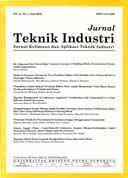Developing a Group Model Building Causal Loop Diagram to Understand Millennial Generation Trust in Twitter as Early Warning System for Natural Disaster
DOI:
https://doi.org/10.9744/jti.23.1.35-46Keywords:
Early Warning System, Twitter, Millennial, System Dynamics, Causal Loop Diagram, Group Model BuildingAbstract
Nowadays, Twitter is used as an Early Warning System (EWS) for disasters because of the speed and many users. Based on Asosiasi Penyedia Jasa Internet Indonesia (APJII) data, in 2017, almost 50% of internet users in Indonesia are born in 1983-1998. They are called the millennial generation. Therefore, this study aims to explore the trust of millennials towards Twitter as an EWS. This study utilizes the conceptual model from System Dynamics named Causal Loop Diagram (CLD) to identify the factors and the causal relationship among millennials' factors to trust Twitter as an EWS. It involves ten participants from the millennial generation, consisting of five passive Twitter users and five active Twitter users. A semi-structured interview was conducted with all participants to build the initial CLD gathered from each participant's perspective. Afterward, the initial CLD was verified by all participants through Focus Group Discussion. A group model building CLD that represents the influencing factors and their causal relationship of millennial generation trust in Twitter as EWS for a natural disaster is successfully developed from this study. The tweet frequency, the number of followers, the account credibility, the verified account, the level of trust in social media, and the content quality are considered the underlying factors of active and passive users to trust in Twitter as an EWS natural disaster.
Downloads
References
Badan Nasional Penanggulangan Bencana (BNPB), Bencana Tahun 2018, 2018, retrieved from https://apjii.or.id/.
Klein, B. D., User Perceptions of Data Quality: Internet and Traditional Text Sources, Journal of Computer Information Systems, 41(4), 2001, pp. 9–14.
Asosiasi Penyelenggara Jasa Internet Indonesia (APJII), Penetrasi dan Perilaku Pengguna Internet Indonesia 2017, 2017, retrieved from https://apjii.or.id/.
Chatfield, A. T., and Brajawidagda, U., Twitter Early Tsunami Warning System: A Case Study in Indonesia’s Natural Disaster Management, Proceedings of the Annual Hawaii International Conference on System Sciences, 2013, pp. 2050–2060.
Carley, K. M., Malik, M., Landwehr, P. M., Pfeffer, J., and Kowalchuck, M., Crowd Sourcing Disaster Management: The Complex Nature of Twitter Usage in Padang Indonesia, Safety Science, 90, 2016, pp. 48–61.
Strauss, W., and Howe, N., Millenials Rising: The Next Great Generations, Vintage Books, New York, 2000.
Mason, M., Sample Size and Saturation in PhD Studies Using Qualitative Interviews, Forum Qualitative Social Research, 11(3), 2010.
B Saunder, B., Sim, J., Kingstone, T., Baker, S., Waterfield, J., Bartlam, B., Burroughs, H., and Jinks, C., Saturation in Qualitative Research: Exploring Its Conceptualization and Operationalization, Quality and Quantity, 52(4), 2018, pp. 1893–1907.
Sterman, J. D., Business Dynamics: Systems Thinking and Modeling for a Complex World, McGraw-Hill, Boston, 2000.
Thomson, R., Ito, N., Suda, H., Lin, F., Liu, Y., and Hayasaka, R., Trusting Tweets: The Fukushima Disaster and Information Source Credibility on Twitter, 9th ISCRAM Conference, 2012, p. 10.
Castillo, C., Mendoza, M., and Poblete, B., Information Credibility on Twitter, Proceedings of the 20th International Conference on World Wide Web, 2011, pp. 675–684.
Comrie, E., Burns, C., Coulson, A., Quigley, J., and Quigley, K., Rationalising the Use of Twitter by Official Organisations During Risk Events: Operationalising the Social Amplification of Risk Framework through Causal Loop Diagrams, European Journal of Operational Research, 272(2), 2019, pp. 792–801.
Santos, R. M., Mosse, D., Znati, T., and Comfort, L. K., Design and Implementation of a Witness Unit for Opportunistic Routing in Tsunami Alert Scenarios, Safety Science, 90, 2016, pp. 75–83.
Flanagan, J., Early Warning System for Natural and Manmade Disasters, US Patent 1999.
Tinker, T., and Vaughan, E., Risk and Crisis Communications: Best Practices for Govern-ment Agencies and Non-Profit Organizations, Booz Allen Hamilton, 2010.
Bornmann, L., and Haunschild, R., T factor: A Metric for Measuring Impact on Twitter, Malaysian Journal of Library and Information Science, 21(2), 2016, pp. 13–20.
Liu, I. L. B., Cheung, C. M. K., and Lee, M. K. O., Understanding Twitter Usage: What Drives People Continue to Tweet, Proceedings of the Pacific Asia Conference on Information Systems, 92, 2010, pp. 927–939.
Landwehr, P., Wei, W., Kowalchuck, M., and Carley, K. M., Using Tweets to Support Disaster Planning, Warning and Response, Safety Science, 90, 2016, pp. 33–47.
Downloads
Published
How to Cite
Issue
Section
License
Articles published in the Jurnal Teknik Industri: Jurnal Keilmuan dan Aplikasi Teknik Industri will be Open-Access articles distributed under the terms and conditions of the Creative Commons Attribution License (CC BY).
![]()
This work is licensed under a Creative Commons Attribution License (CC BY).



















